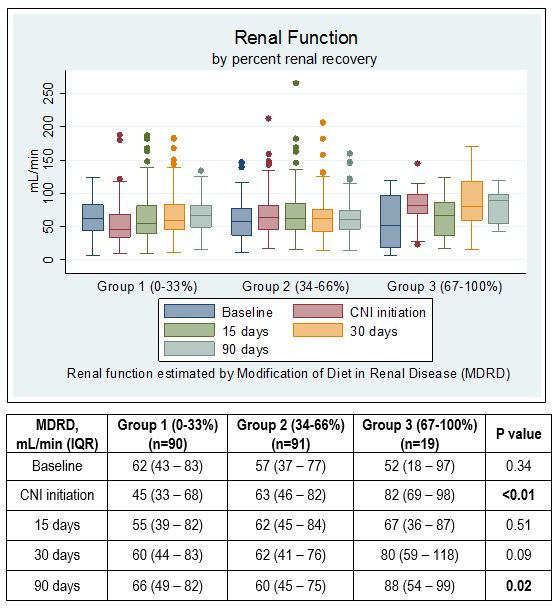Delayed Calcineurin Inhibitor Introduction and Long Term Renal Outcomes in Liver Transplant Recipients Receiving Basiliximab Induction.
1Department of Pharmacy, Weill Cornell Medical Center, New York, NY
2Department of Pharmacy, Columbia University Irving Medical Center, New York, NY
Meeting: 2017 American Transplant Congress
Abstract number: D202
Keywords: Liver transplantation, Monoclonal antibodies, Renal dysfunction
Session Information
Session Name: Poster Session D: Liver: Immunosuppression and Rejection
Session Type: Poster Session
Date: Tuesday, May 2, 2017
Session Time: 6:00pm-7:00pm
 Presentation Time: 6:00pm-7:00pm
Presentation Time: 6:00pm-7:00pm
Location: Hall D1
BACKGROUND Basiliximab may be used to delay the initation of calcineurin inhibitors (CNI) in patients with renal injury after liver transplantation (LT). The optimal time to introduce a CNI to portend favorable long-term renal outcomes is unknown.
METHODS All adults transplanted between 01/07-12/15 who received basiliximab were included in a retrospective analysis. We evaluated 90 day renal outcomes stratified both by severity of renal injury and degree of achieved renal recovery (=1-[SCr at CNI initiation]/[max post-LT SCr]). The primary outcome was the percentage of patients who remained within Acute Kidney Injury Network (AKIN) criteria at 90 days post-LT.
RESULTS 200 LT recipients were included. Three-group stratification occurred by percent renal recovery at the time of CNI initiation: 0-33%, 34-66%, 67-100%. No differences in baseline characteristics were identified, except MELD scores, which were highest in Group 3 (22 vs. 24 vs. 27, p<0.01). For the primary outcome, 98 (49%) patients met AKIN criteria at baseline vs. 24 (12%) patients at 90 days post-LT; no between-group differences were observed. At 90 days post-LT, patients with 67-100% renal recovery at the time of CNI initiation (Group 3) had significantly greater eGFR (66 vs. 60 vs. 88 mL/min, p<0.02). No between-group differences were observed in CNI concentrations at any time point.
CONCLUSION Patients with the largest percent of renal recovery at the time of CNI initiation had the greatest eGFR at 90 days post-LT, despite having higher MELD scores at baseline.
| Characteristic | Group 1 (0-33% recovery) | Group 2 (34-66% recovery) | Group 3 (67-100% recovery) | p-value |
| Baseline AKIN class, n (%) | 0.17 | |||
| None | 53 (59) | 40 (44) | 9 (47) | |
| 1 | 15 (17) | 22 (24) | 4 (21) | |
| 2 | 13 (14) | 22 (24) | 2 (11) | |
| 3 | 9 (10) | 7 (8) | 4 (21) | |
| Remain in AKIN at 90 days, n (%) | 8 (9) | 14 (15) | 2 (11) | 0.43 |
CITATION INFORMATION: Lange N, Salerno D, Sammons C. Delayed Calcineurin Inhibitor Introduction and Long Term Renal Outcomes in Liver Transplant Recipients Receiving Basiliximab Induction. Am J Transplant. 2017;17 (suppl 3).
To cite this abstract in AMA style:
Lange N, Salerno D, Sammons C. Delayed Calcineurin Inhibitor Introduction and Long Term Renal Outcomes in Liver Transplant Recipients Receiving Basiliximab Induction. [abstract]. Am J Transplant. 2017; 17 (suppl 3). https://atcmeetingabstracts.com/abstract/delayed-calcineurin-inhibitor-introduction-and-long-term-renal-outcomes-in-liver-transplant-recipients-receiving-basiliximab-induction/. Accessed December 13, 2025.« Back to 2017 American Transplant Congress

